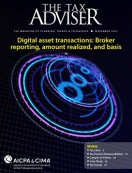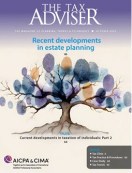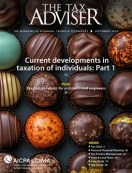- tax clinic
- ESTATES, TRUSTS & GIFTS
A trust is not always a trust for federal income tax purposes
Related
Estate of McKelvey highlights potential tax pitfalls of variable prepaid forward contracts
Recent developments in estate planning
Guidance on research or experimental expenditures under H.R. 1 issued
Editor: Robert Venables, CPA, J.D., LL.M.
When engaged in tax planning or tax compliance, tax professionals may encounter classification of the taxpayer as an issue. Often, in-depth analysis is not necessary, either because the classification is obvious or the adviser is relying on prior tax filings or affirmative statements by the taxpayer or other advisers.
The typical indications to tax advisers that they are dealing with a trust comes from the documentation of the arrangement as a trust agreement, a declaration of trust, a trust indenture, or a trust deed. The documentation contains the term “trust” in its title, or the first paragraph of the document describes the parties, including the trustee(s). The tax professional’s analysis, however, should not stop here. Under federal income tax law, distinctions are made among:
- Ordinary trusts that file Form 1041, U.S. Income Tax Return for Estates and Trusts, for domestic trusts, or Form 1040-NR, U.S. Nonresident Alien Income Tax Return, for foreign trusts;
- Business trusts that file as corporations, partnerships, or disregarded entities;
- Investment trusts; or
- Liquidating trusts.
In some situations, the document may on its face create a trust, but the arrangement may be considered a mere nominee for federal income tax purposes.
In the foreign context, especially when dealing with civil code countries, the term “trust” may not even appear in the documentation of the arrangement. Examples of terms used include stiftung, privatstiftung, anstalt, stichting, and foundations. However, these entities often will be classified as trusts for federal income tax purposes.
This item focuses on the criteria to distinguish among ordinary trusts, business trusts, and situations in which a purported trust is a mere nominee for another entity. For tax professionals, the distinction is of the upmost importance in determining whether they are preparing and filing the correct income tax return or form with the IRS. Furthermore, if the arrangement is considered a foreign trust, substantial penalties may be imposed for failure to properly file Form 3520-A, Annual Information Return of Foreign Trust With a U.S. Owner, and Form 3520, Annual Return to Report Transactions With Foreign Trusts and Receipt of Certain Foreign Gifts.
Ordinary trusts
Regs. Sec. 301.7701-4(a) defines a “trust” as follows:
In general, the term “trust” as used in the Internal Revenue Code refers to an arrangement created either by a will or by an inter vivos declaration whereby trustees take title to property for the purpose of protecting or conserving it for the beneficiaries under the ordinary rules applied in chancery or probate courts. Usually the beneficiaries of such a trust do no more than accept the benefits thereof and are not the voluntary planners or creators of the trust arrangement. However, the beneficiaries of such a trust may be the persons who create it and it will be recognized as a trust under the Internal Revenue Code if it was created for the purpose of protecting or conserving the trust property for beneficiaries who stand in the same relation to the trust as they would if the trust had been created by others for them. Generally speaking, an arrangement will be treated as a trust under the Internal Revenue Code if it can be shown that the purpose of the arrangement is to vest in trustees responsibility for the protection and conservation of property for beneficiaries who cannot share in the discharge of this responsibility and, therefore, are not associates in a joint enterprise for the conduct of business for profit.
The key elements in this definition are (1) trustees holding title to the property and (2) doing so for purposes of protecting and conserving the property for the beneficiaries. Tax advisers reviewing the documentation, facts, and circumstances surrounding a particular entity should examine these factors and determine whether the entity is a person owning or holding title to property for the purpose of protecting, conserving, and investing those assets for the benefit of beneficiaries.
Business trusts
Regs. Sec. 301.7701-4(b) defines a business trust as follows:
There are other arrangements which are known as trusts because the legal title to property is conveyed to trustees for the benefit of beneficiaries, but which are not classified as trusts for purposes of the Internal Revenue Code because they are not simply arrangements to protect or conserve the property for the beneficiaries. These trusts, which are often known as business or commercial trusts, generally are created by the beneficiaries simply as a device to carry on a profit-making business which normally would have been carried on through business organizations that are classified as corporations or partnerships under the Internal Revenue Code. However, the fact that the corpus of the trust is not supplied by the beneficiaries is not sufficient reason in itself for classifying the arrangement as an ordinary trust rather than as an association or partnership. The fact that any organization is technically cast in the trust form, by conveying title to property to trustees for the benefit of persons designated as beneficiaries, will not change the real character of the organization if the organization is more properly classified as a business entity under [Regs. Sec.] 301.7701-2.
The key element in this definition of business trusts is the creation of an arrangement to carry on a profitmaking business. The 2023 Tax Court case Fairbank, T.C. Memo. 2023-19, elaborates on this element to assist the tax professional with the task of determining whether an entity is a business entity or a trust.
In Fairbank, the Tax Court provided a useful summary of the cases to date that have analyzed whether an arrangement should be treated as a trust or a business entity. The facts before the court involved a Liechtenstein establishment of which the taxpayer was the beneficial owner. The establishment’s sole asset was a Swiss bank account into which the taxpayer’s former husband made cash deposits via his Swiss attorney in fulfillment of child support obligations. An issue before the court was whether the establishment was a foreign trust subject to informationreporting requirements under Sec. 6048. The taxpayer argued that the establishment was a controlled foreign corporation for federal income tax purposes. The government disagreed and took the position that the establishment was a trust. The taxpayer was audited and was before the court as a result of a “John Doe” summons issued to a Swiss bank requesting information with respect to its U.S. accountholders.
The court confirmed that the analysis to determine whether an entity is a trust or a business entity rests on the facts and circumstances of the case. Looking to Regs. Sec. 301.7701-4(a), quoted above, the court stated that the four elements necessary to have a trust are (1) a grantor, (2) a trustee holding title to property for the purpose of protecting or conserving it, (3) property, and (4) designated beneficiaries. For an arrangement to be a business entity, it must include associates and an objective to carry on a business. After reviewing the facts, the court concluded that the establishment had neither of the elements of a business entity, resulting in the court’s holding that it was a trust for U.S. income tax purposes.
Mere nominee arrangement
In two revenue rulings — Rev. Rul. 92-105 with respect to an Illinois land trust and Rev. Rul. 2013-14 with respect to a Mexican land trust — the IRS ruled that when a trustee’s only responsibility is to hold and transfer title to property at the direction of the settlor/beneficiary, a trust has not been established for federal income tax purposes. Under these circumstances, the trustee is an agent of the settlor/beneficiary. This conclusion follows from the facts and circumstances, which revealed that the trustee had no obligation to protect and conserve the property because the direction, management, and control of the asset fell to the settlor/beneficiary.
Determining a purported trust’s status
Tax professionals who focus on trusts and estates may receive requests for consultation from tax colleagues concerning a trust contained in a business organizational chart or the characterization of a foreign entity. If the trust is at the top of the organizational chart, its characterization likely will be as an ordinary trust owning equity interests in the underlying business entities for the benefit of its beneficiaries. If the “trust” sits in the middle of the organizational chart, it may be a mere agent or business entity. The estate and trust professional will need to explore the organization documents, the purpose for forming the “trust,” and the context surrounding the entity. If the estate and trust professional concludes that the “trust” is a business entity, the trust professional may return the matter to their business entity colleagues for assessment and options as to whether the entity is a corporation, partnership, or disregarded entity. Conversely, if the entity is a trust, then further consultation will be necessary regarding the status of the trust as domestic or foreign, grantor or nongrantor, and simple or complex.
In a foreign-entity context, a determination similar to that in the Fairbank decision will be necessary. If the entity is conducting a business or has a business purpose, it is likely a business entity. If the foreign entity is a trust, further analysis will be required. If U.S. persons are grantors and/or beneficiaries, foreign trust informational Forms 3520-A and 3520 may be required. Failure to timely file those forms may result in the imposition of substantial penalties on the U.S. grantor and/or beneficiary.
Editor Notes
Robert Venables, CPA, J.D., LL.M., is a tax partner with Cohen & Co. Ltd. in Fairlawn, Ohio.
For additional information about these items, contact Venables at rvenables@cohencpa.com.
Contributors are members of or associated with Cohen & Co. Ltd.














